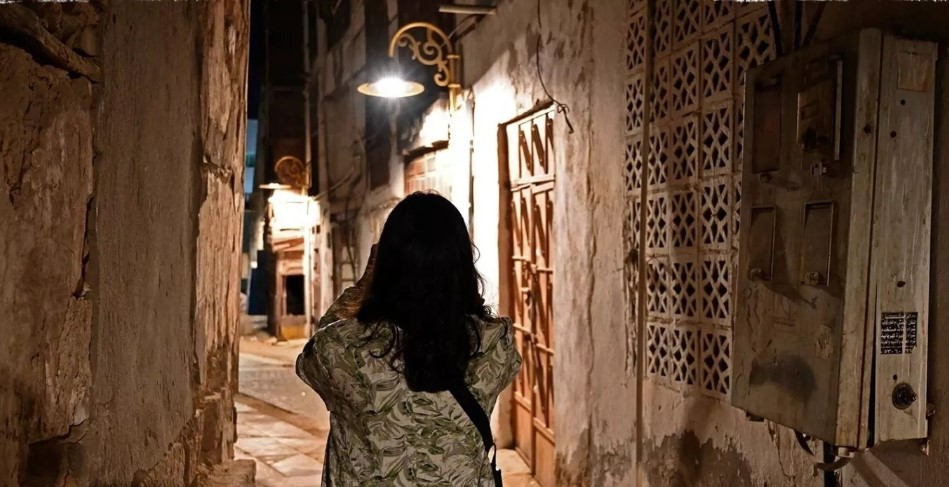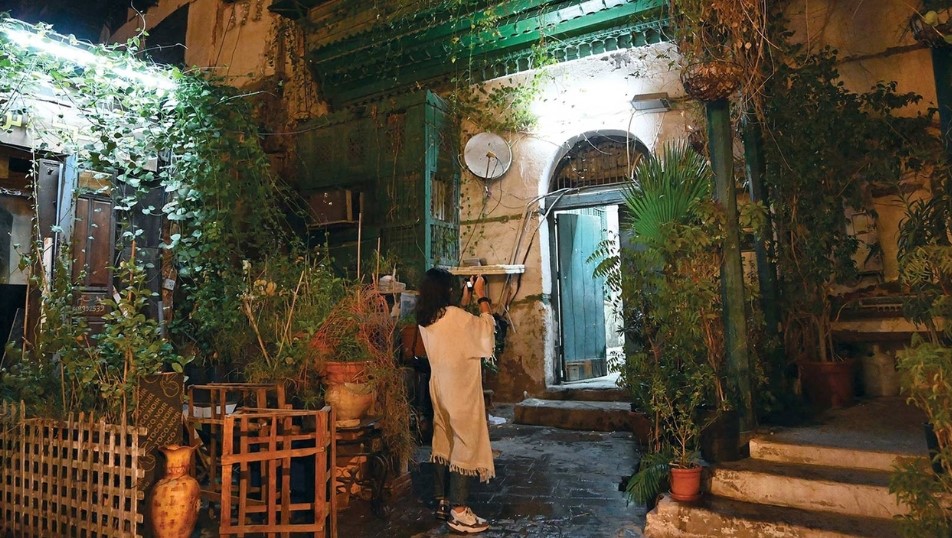Before naming it as the royal seaport for Makkah at 657 AD, the Al-Balad site, “Historic Jeddah”, was built on beautiful coastal land. It gathered people from all cultures and walks of life throughout the ages. This part of the world unveils a human heritage whose walls challenged different historical factors with eight gates; each is known for its historical stories. In addition, it holds more than 10 ancient houses praised for their distinctive designs and the names of their ancient families. Here, you will get the coziest photographs.

A Heritage recognized by the world
Discover the place chosen amongst UNESCO World Heritage List, where the ancient homes transformed using the latest technologies and expertise into art galleries and specialty cafes. Whenever you look up in AL-Balad, you see the wooden Rawashins hanging overhead as an example of authentic architecture that oversees the modern life that passes beneath it.
The magic of Al-Balad site, “Historic Jeddah”, is not limited to the heritage value surrounding you, but also to the unique location being twenty minutes away from the best shopping experiences and international restaurants, and another twenty minutes away from the largest and most important car race in the world; the STC Formula 1 Saudi Grand Prix.

Doors to Jeddah Wall
Once you reach Historic Jeddah, you will notice several doors. These doors that go back to ancient times used to get closed at night as a form of security and protection to the markets of the old alleys they surrounded. Almost every side has a door, the most famous of which is from the east: “Bab Jadeed”. This latest addition to the doors was built during the Saudi rule at the beginning of the nineteen forties. Next in importance comes “Bab Makkah” from the east side facing Souq Al Badu intended to protect this market and form a passage. Then, from the south side comes “Bab Shareef” used by the people of these alleys for outings and visiting outside markets, such as “Haraj Al Asr”, which has developed into a large local market.

Tour of the most exquisite ancient houses
Bait Nassif
Start your journey through history inside the ancient houses of Albalad with Bait Nassif. As you enter Bait Nassif, you stand on the grounds of the first orientally designed Arabic house in Jeddah. It has been used throughout the years as a temporary residence for kings and scholars. With 40 wide rooms with high ceilings, its floors transformed into art galleries and cozy cafes, where you can enjoy the company of your family or friends in evenings full of joy and storytelling.
Bait Matbouli
Let your walking journey take you next to the well-preserved architectural beauty of Bait Matbouli. The experience of walking around here resembles walking into a heritage museum, where every turn has an art painting. This marvellous historic masterpiece dates back to 420 years ago. The building walls have been purposefully constructed to reduce heat and retain a pleasant temperature. It combines a unique blend of local materials, oriental architecture designs, and the use of beyond-the-sea cultures in interior design, where wood was imported from East Asia and Al-Mangabi Stones excavated from the Red Sea waters.
Bait Nour Wali
Next, you can head to Bait Nour Wali. The building is hard to miss with its unique green protruded delicately inscribed windows, a distinctive feature of Jeddah’s ancient architecture known as Rawashin. Another incredible architectural design feature is that it holds an efficient water system consisting of wall-build pipes that drain rainwater into a ground tank.
This house was built by the architectural enthusiast local “Muhmood Al-Sabban”. Several years later, on 1946AD it was sold to Abdulgader Nour Wali, and that is where the house got its name. It has been long withstanding as one of the spectacular architectural beauties of Historic Jeddah.
Beit Alsharbatly
Get your camera ready, you’ve reached one of the most ancient and infamous houses of Historic Jeddah; Beit Alsharbatly. It remains since built in 1916AD by Sharif Abdullah Al-Abdali, steadfast with its bright white columns and distinctive wooden windows and balconies overlooking the prominent sites of the area. As time has passed on this beauty, each of its carefully picked tiles became an antiquity inscribed “Made in Al-Hijaz – Jeddah.”
All these fascinating details won’t take you away from its unique history. Formerly, the building was the headquarters of the Egyptian Embassy in Saudi Arabia. Its four floors once witnessed extensive fruitful meetings. Now, it has turned into a cultural centre and a favourite location for art galleries and cultural events.
You can wander around its antique halls and rooms but don’t miss the chance of gazing through one of its unmatched precisely designed wooden balconies and admire the view of the surrounding ancient house at sunset.
Bait Qabil
Bait Qabil is placed in the heart of the special area and at the center of the historic events. Its ceilings were intentionally made tall which is an old mechanism used to allow air passage and purification inside the house. To testify for its incredible architectural design, many artistic mockups are made of its highly crafted Rawashins. The merchant Suliman Qabil was able to single-handedly turn the Qabil Street into one of the most prominent and advanced streets of Jeddah at the time. In fact, it was the first street to be supplied with electricity. Till today, this area is considered one of the most significant locations in Jeddah due to its history and heritage. This house and its surrounding area open their door to story-filled visits.
Zainal House
Zainal House is located right at the entrance of Historic Jeddah in Al-sham neighbourhood. Bait “Zainal Ali Reda” with all its splendour, still maintaining its engraved windows as well as stone inscribed door, reflects the artistic nature of that time period. Now, this once one of the most magnificent ancient houses in the area, has developed into an exhibit that sheds light on that era. It served many purposes, one of which is the centre of the Embassy of Holland, where it got its other name Bait Hollanda. In addition, it has welcomed pilgrims coming from Asia and regulated their trip to Makkah.
Bait AlBatterjee
The charmingly antique three-floored Bait AlBatterjee will catch your eyes as you enter AlBalad area with its attractive colors and thick construction. It was the first headquarters of the American embassy in Jeddah. Today, it has been renovated to reflect its ancient belongings from furniture and rare devices, such as the first Saudi telephone with a “Two swords and a palm” slogan. On the inside walls of the house hangs pictures portraying the significant role it has played. The unique details and history stemming from this house and its surrounding area make it a special destination for tourists.
Bait Baeshen
Bait Baeshen took the lead as a social and cultural center as it was the gathering place of the notables of Jeddah in the past. Nowadays, it is an amazing tourist destination with its splendid architecture manifested in its gorgeous Rawashins and its meticulously built balconies. It was built according to the highest standards of Islamic art by Shaikh “Muhammed Saleh Ali Baeshem” in 1273AH. Today, the house displays exquisite handicrafts and documents on rare photographs and manuscripts.
Bait AlRashaida
Right in the middle of Bait AlRashaida is a carved plaque with a Quranic verse that dates back to 1301AH. This house was well known for hosting all academic activities. It has still maintained its identity with artwork on Jeddah’s heritage on display made by the hands of Saudi artists. Art sessions are held there from time to time as well. Art lovers and cultural explorers can bit on fond memories here.
Bait Sallom
Bait Sallom has turned into ”House of Jeddah and Our Good Days” museum. It has wonderfully preserved all its belonging as if it was a time capsule for Al-Balad area. Although it shares the same place and time period of Bait Nassif, yet it distinctly preserved more of its social belongings. On your family tour, you can show your kids the “gramophone” musical device, old canned food and coins, and the first versions of the popular soft drink.

More sites that strike into the heart of history
Rebat Alkhonji
Rebat Alkhonji is considered one of the prominent Islamic architectural designs in AlBalad area. For more than 200 years, it has served as social and humanitarian housing for old, lonesome, and traveller females. Built by Muhammed Alkhonji in 1813AD, this building with its longstanding history had nonstop conversations in the Al-Sham neighbourhood within Historic Jeddah.
Al Shafei Mosque
Registered as one of UNESCO’s world heritage sites, AlShafei mosque was built during the reign of The Caliphate Omar Bin Khatab. Its marble pillars and Al-Mangabi Stones date back to 1400 years. However, its minaret goes back 850 years as a recent addition because old mosques are built without minarets. Here, lessons on Alshafei school of thought were held, and, thus, it was named after it. Close by, you may find an ancient building called “Waqf Alshafei”.It is distinguished by its Rawashins. This is a great stop in your journey to witness the classic Hejazi architectural designs and the impact of time on them.
Al-Mimar Mosque and Ain Farag Yosr
Al-Mimar Mosque is the second oldest mosque in Jeddah. It is adorned with oriental inscriptions and engraved with Quranic verses on its walls. An ancient well lined up from the inside and outer area with Al-Mangabi Stones, excavated from the Red Sea waters, is directly connected to the mosque. The well was responsible for its water supply. When the water became scares in the well, water was brought from the spring “Ain Farag Yosr”. Travelers pay it a visit for its historical status, to pray in it, and to enjoy its architectural artistic design.
The spring “Ain Farag Yosr” was intended initially to supply the old “Al-Mazloum and Al-Yaman ” neighborhoods in Historic Jeddah. Since dug, it supplied water until it completely dried on 1304AH. Today, it showcases its long precious history of welcoming guests and those fascinated with antiquities and local heritage.

Markets with doors throughout all times
Historic Jeddah has long been the home of the most ancient folk markets throughout the ages. It is the ideal destination for heritage and souvenirs lovers and seekers of craftsmanship and handmade goods as well as hard-to-miss offers.
In Al-Balad area, you will be greeted by “Alawi Market”, which extends on Qabil Street. This authentically joyful market offers traditional, oriental and Hijazi attires as well as precious stones on display. At the end of this market, you will reach the constantly vibrant “Souq Al Badu” market. This market was precisely the starting point of most prominent local entrepreneurs today. Just walking inside its culturally rich places with simple friendly gestures of its people is an experience unlike anything else in Jeddah.
As you wander around in AlBalad area you will find “Barhat Al Shagara” where the unique individual markets of “Al Khaskeya” are located. The crafty salesmen offer authentic and valuable handmade merchandise. Also, the many wholesale centers inside it offer anything you can think of.
“Souq Al-Nada” is another interesting option, located also inside Historic Jeddah between old buildings and fast-food stands.
When you reach the end of your shopping journey, don’t forget to pass by AlBalad Souvenirs and Jeddah Souvenirs for some amazing takeaways, such as tiny mock-ups of ancient houses in the Al-Balad region, and many more innovative gifts to keep you reminded of this unique visit.

Restaurants that welcomed all passers
After your tour of these nearby markets, looking for a quick bite to eat, Jeddah style, you won’t find anyone that fails to suggest the delicious “Shawarma Shaker”.
You can also try to book in advance in the cozy authentic “Baisi Ras Al Mandi” restaurant that offers a limited menu of local traditional dishes. The vibe of the place takes you back to the times of Historic Jeddah.
For a wonderful kick start of the day, you must visit the 200-year-old “Al-Saidi Furn” bakery that opens its doors at 7:00 AM. It is infamous for the most delicious baked goods such as “Al-Shareek” and “Futt”. It is only 22 minutes away from the oldest branch of “Furn Al-Sheikh” -a 100-year-old bakery, which bakes a unique bread infused with fennel and black seed, a long favorite for locals.

Lake Al-Arbaeen: Your #1 destination for good food and good company
Visitors will have the opportunity to enjoy Jeddah’s historic district by strolling through Lake Al-Arbaeen, trying different traditional cuisines from various food stands that line up across the park.
Grab a plate, take a seat and enjoy your time in one of the park’s seating areas. You will be captivated by the joyous atmosphere of the place and its relaxing ambient lights.
The Architectural Styles of Jeddah
Jeddah’s Architecture Will Forever be Engraved in Your Memory
Close to the shores of the Red Sea and its enchanting natural beauty, you will find the authentic spirit of Jeddah manifested in the old highly crafted and masterly artistic houses. This urban pattern of Jeddah’s artistically imbued houses has a rich culture that spans to many decades ago. You will not cease to be amazed by the delicate balance these architectural designs strike between beauty and societal and environmental goals.

The Innovative Outdoor Mashrabiya
Islamic architecture traces back to the sixth century, in the Hijri calendar (the eleventh century in the Gregorian calendar), when the so-called “Mashrabiya” emerged, a breathable ventilation mechanism distributed along the entire facade of the house or only allocated to the windows of the high floors. The carefully detailed carvings and ornaments of latticed teak wood were used to create an unprecedented beauty in the surrounding alleys and streets. You can also witness the ingenuity of carpentry and the splendor of the ” Mashrabiya ” designs in the historic Al-Balad region. ” Mashrabiya ” was one of the most innovative tasteful creations to resolve problems such as privacy, ventilation, lighting, and humidity all at once while still maintaining high artistry indicative of high skill.

The Skilfully Crafted Rawashin
Derived from the concept of a window but falling shy from a balcony is the elegant idea of Rawashin. It is uniquely distinguished in two details: on one hand its protrusions from the house’s facade and the mix of glass and wood in their assembly; on the other hand, the astonishing delicate and crafty inscriptions lined sometimes with dark or colored glass that comes in different shapes, types, and details. The way the light peeks through them into the houses is a sight that lights up the soul. Rawashins are utilized as a view to the outside, or, when they are at the top of the house, a storage space. Today, you can still see the marvelous details in them at the 300-year-old Baeshen Palace. The emergence of external porches, which were called in the past “Rawashin” and more recently as “balconies”, was inspired by the same idea, and it was the first design of houses that contain external balconies with distinctive oriental designs in Jeddah.

White Stone Building Trick
Ancient buildings didn’t get their allure from the skilled carpentry alone. Additionally, instead of using cement, most buildings were uniquely made from special coral limestone extracted from the Red Sea called “Al-kashur” or “Al-Mangabi Stones”, which were used in almost all traditional constructions. A distinguished exclusive quality of these houses not found anywhere else in the rest of the world, at the time, is that they were constructed in a way that would allow them to be dismantled and reassembled if a part of the Hijazi house was damaged. This feature was feasible due to the use of “Teklela” or “Tekeel” wood to separate the light and fragile coral stones. You can go on an exploration tour of this art in “House of Jeddah and Our Good Days”.

Delightful Nights Indoors
The entrance of the house is intended to greet guests. At the doorway, you will be met with a reception room called “dehleez”. This intimate charming room is furnished with seats, around four in small houses, sand-filled floors, and exquisite intricately made wall-hanging carpets. These houses overlook small yards, streets, and alleys bustling with street vendors and salesmen, a scene that takes you back to the wonderful old times like a scene from a theatrical play. Some of Jeddah’s historic sites preserved this feeling, such as Al-Balad.
